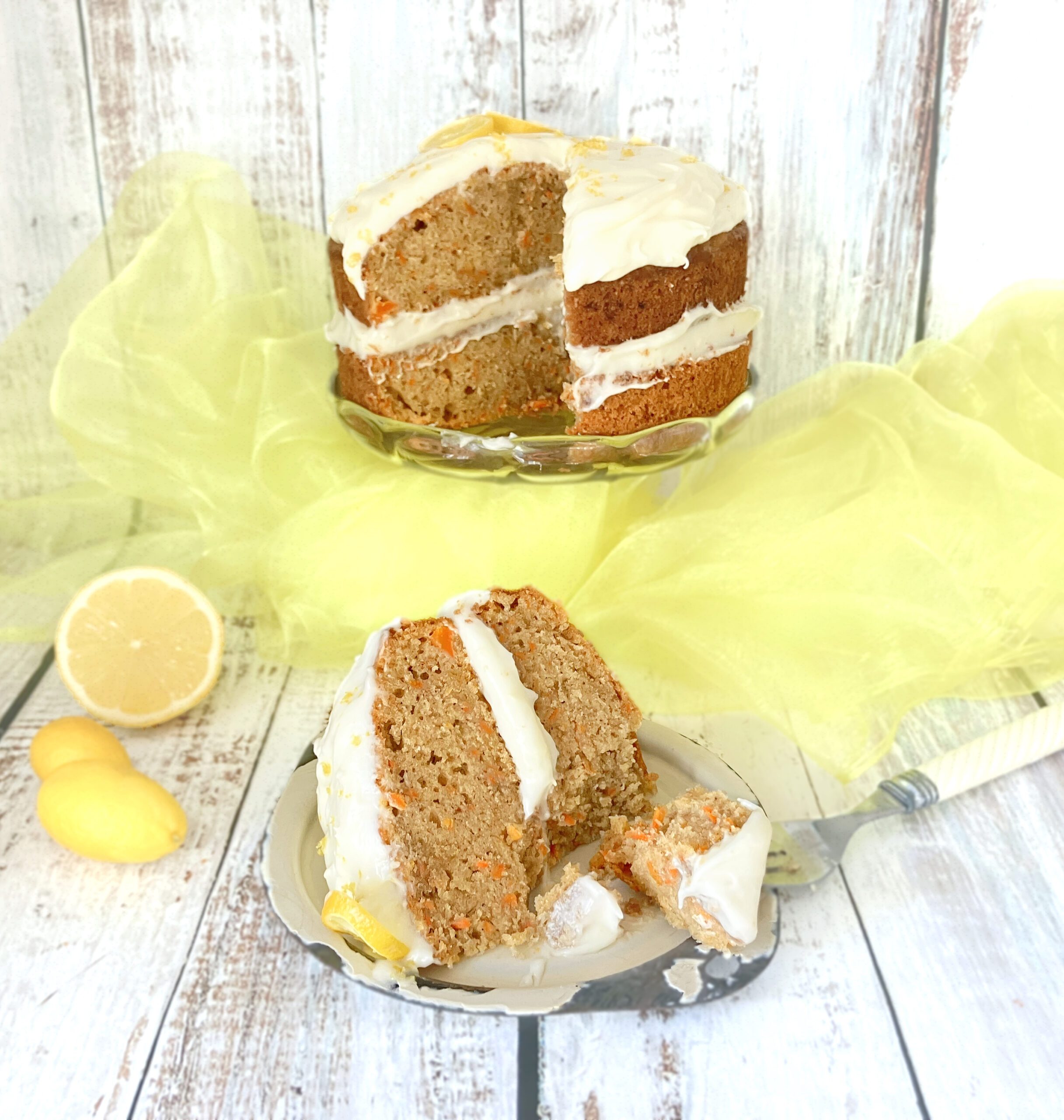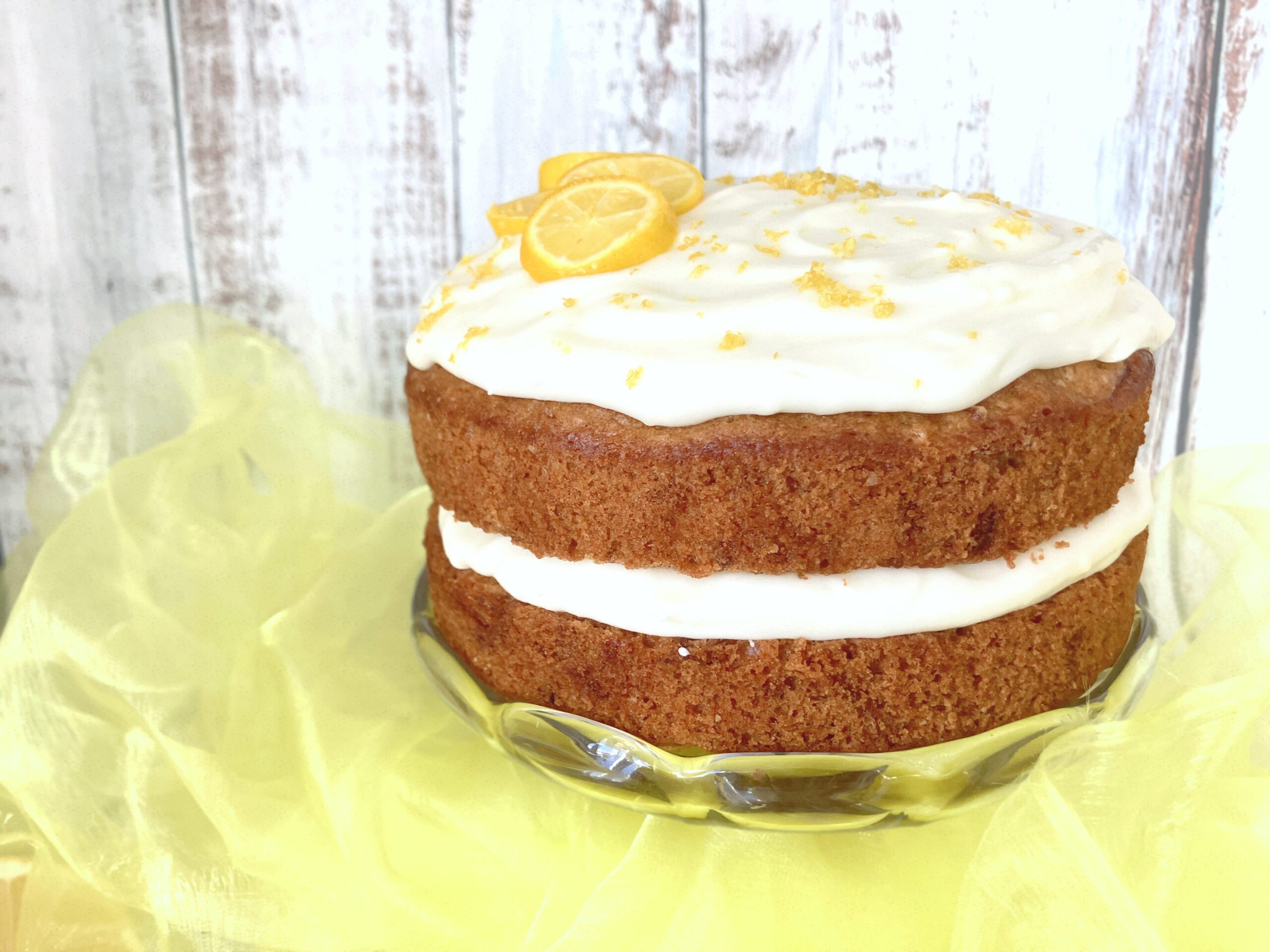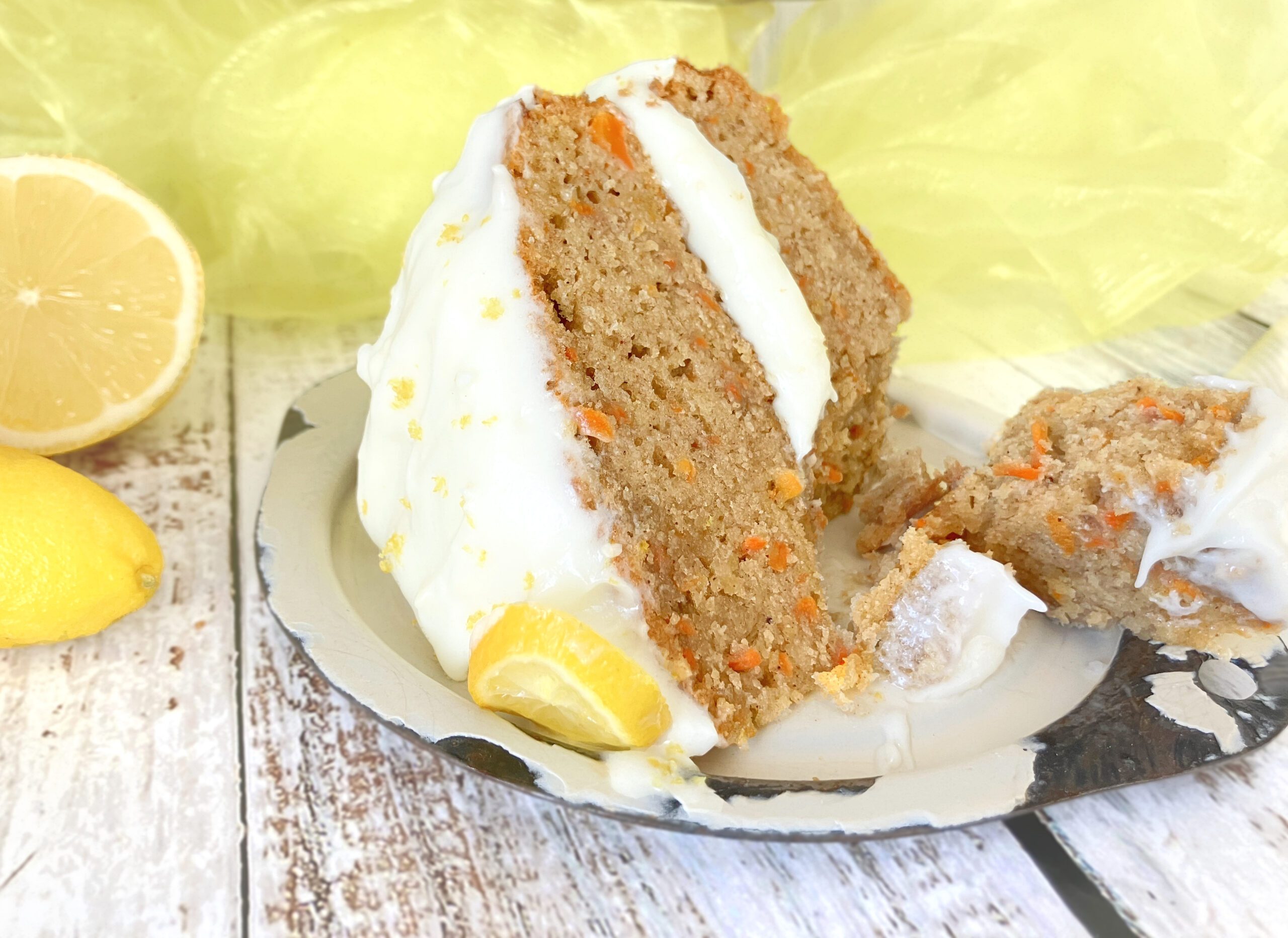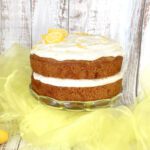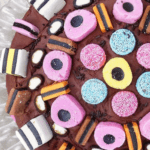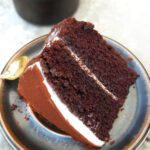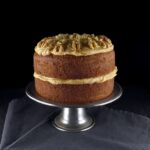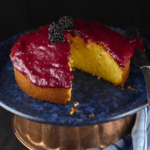Layered Brown Sugar Spelt Carrot Cake (with Lemon Cream Cheese Frosting)
This layered brown sugar spelt carrot cake recipe takes a beloved classic to new heights with a two-layer version, perfect for any occasion. The rich, spiced 7″ (18cm) cakes are layered together with a complementary tangy lemon cream cheese frosting, creating a harmonious balance of flavors.
With a slightly healthier twist, thanks to the brown sugar and spelt flour, this cake is dense and indulgent. With 10-12 slices, this cake works whether you’re celebrating a special event or simply treating yourself.
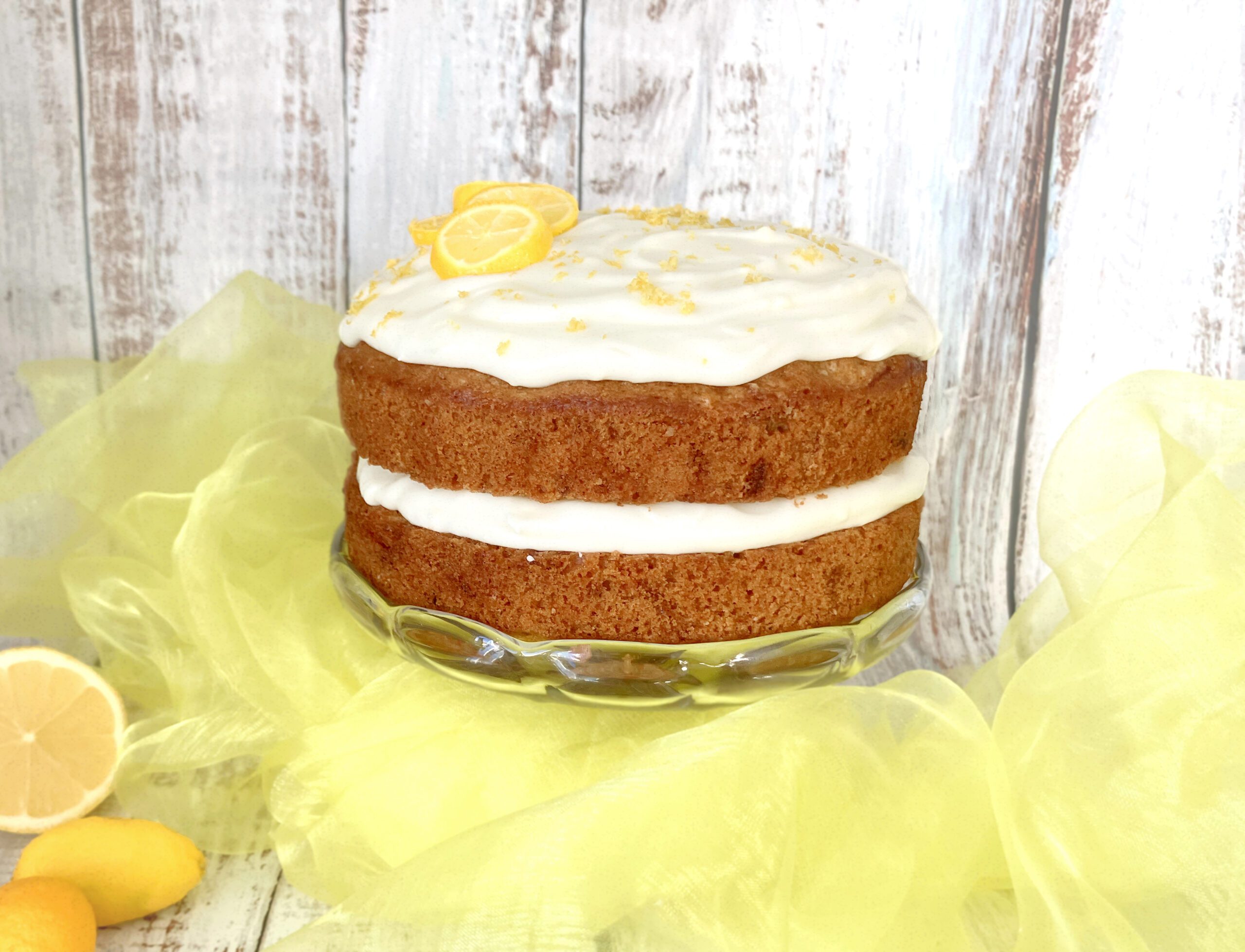
I’ve previously made a one-layer version of this cake with an Easter theme, and it’s been a favourite for more than 20 years. This time, I wanted to take it up a notch, so I decided to create a two-layer version. To really highlight those delicious layers, I used 7” (18cm) pans to create a nicely sized cake that would be easy to frost and serve.
Still keeping the spring theme, this cake captures the essence of the season. The soft, tender layers paired with the tangy lemon cream cheese frosting make for a truly irresistible combination. Whether you’re making it for a celebration or just because you deserve something sweet, this cake is sure to impress.
Carrot cakes: a brief history
Carrot cake, as we know it today, has uncertain origins, but its roots likely trace back to medieval Europe. During this time, sugar and sweeteners were expensive, so people often used naturally sweet ingredients like carrots in puddings and cakes. Some food historians believe early versions of carrot cake evolved from carrot puddings, which were popular in England and other parts of Europe as far back as the 10th century.
A more recognisable form of carrot cake appeared in the 19th century, with recipes found in European cookbooks. One notable example is the Swiss Rüeblitorte, a traditional carrot cake that remains popular today. However, it wasn’t until the 20th century that carrot cake became widely known. During World War II, sugar rationing led British home bakers to turn to carrots as a natural sweetener, helping to boost its popularity.
By the mid-20th century, carrot cake had gained traction in the United States. It became a staple in American bakeries, particularly in the 1960s and 1970s, often paired with the now-classic cream cheese frosting.
Ingredients in a classic carrot cake
A classic carrot cake is made with simple, wholesome ingredients that create its signature moist texture and warm flavor. Grated carrots are the star, adding natural sweetness and keeping the cake soft. Most traditional recipes use a mix of white and brown sugar for sweetness, while oil (instead of butter) helps maintain a tender crumb.
Warm spices like cinnamon, nutmeg, and sometimes ginger enhance the flavor, giving the cake its cozy, spiced aroma. Eggs provide structure, while flour forms the base. Baking powder helps the cake rise, though some recipes also include baking soda.
Like most recipes, carrot cake has evolved, and many versions these days include chopped nuts or raisins for extra texture. Some bakers add crushed pineapple for extra moisture and a subtle fruity sweetness, while others incorporate shredded coconut for a hint of tropical flavor. For a unique twist, some versions swap oil for browned butter, giving the cake a richer, caramel-like flavor. There are even chocolate-infused carrot cakes that combine cocoa with the warm spices for a deeper, slightly bittersweet taste.
Using brown sugar
I first stumbled upon using brown sugar in this carrot cake by accident. One day, I didn’t have any white sugar on hand, and brown sugar was all I had in the cupboard. I wasn’t sure how it would turn out, but I decided to give it a go. To my delight, the brown sugar worked wonders. It added a lovely depth of flavor with a subtle caramel richness. It also made the cake a little healthier. I used only 200g (1 cup) of brown sugar, much less than what’s typically called for in regular carrot cakes.
Carrot cakes usually rely on either white sugar or a combination of both white and brown sugar. White sugar provides straightforward sweetness, while brown sugar adds a more complex, molasses-like flavor. By using just brown sugar, I found the sweetness was perfectly balanced. It complemented the natural flavors of the carrots and spices without overwhelming them. This created a lighter, less sweet cake, which was perfect when paired with tangy, sweet lemon cream cheese frosting.
Spelt flour in carrot cakes
Spelt flour is a fantastic choice for carrot cakes for several reasons. It has a slightly nutty flavor that complements the natural sweetness of the carrots. This enhances the overall taste without overpowering it. Spelt flour also has a more delicate texture than regular wheat flour. This creates a lighter, softer crumb in the cake. The result is a tender, moist cake, which is key for a good carrot cake. Additionally, spelt is often easier to digest for some people, making it a great alternative for those looking for a gentler flour. Overall, spelt adds depth of flavor and a wonderful texture to the cake.
Of course, if you don’t have spelt flour, all-purpose (plain) flour can be substituted, using the same amount.
A pairing made in heaven: carrot cake and cream cheese frosting
No carrot cake is complete without a luscious cream cheese frosting, and this recipe produces a generous amount. Made with just four ingredients: cream cheese, icing sugar, butter, and fresh lemon juice, it strikes the perfect balance between creamy, tangy, and sweet. The cream cheese gives it a velvety texture, while a couple of tablespoons of butter add a hint of richness.
A touch of lemon juice brightens the flavor, cutting through the sweetness and complementing the warm spices of the cake. This frosting is perfect for layering between two cakes, as I’ve done in this recipe, or it can be halved and used to simply top one cake for a lighter finish. Either way, it adds the perfect touch to the carrot cake.
Alternatives to cream cheese frosting
If you’re looking for a change from traditional cream cheese frosting, there are several delicious alternatives that can complement carrot cake just as well. For a lighter option, a whipped cream frosting made with heavy cream, icing sugar, and a touch of vanilla adds a fluffy and refreshing finish to the cake. If you prefer something richer, a buttercream frosting using butter, icing sugar, and a dash of vanilla or cinnamon can provide a smooth, sweet layer that pairs wonderfully with the cake’s spices.
For a slightly tangy twist, mascarpone frosting combines mascarpone cheese, heavy cream, and icing sugar, giving you the creaminess of cream cheese frosting but with a different flavor profile. If you’re looking to keep things dairy-free, a coconut cream frosting made from whipped coconut cream and icing sugar offers a tropical and light alternative. Lastly, for a touch of decadence, a caramel frosting made from brown sugar, butter, and cream creates a rich, buttery glaze that complements the natural sweetness of the carrots.
The finishing touches
To give this carrot cake a vibrant and fresh twist, I topped it off with grated lemon zest and lemon slices. The zest adds a burst of citrus fragrance, enhancing the cake’s flavors and brightening the overall experience. The slices are actually Lemon Snack, which is a unique citrus fruit that is completely edible, including the peel. You can use it to garnish cakes, fruit salads, or even cocktails. They looked so pretty on top of my cake.
Looking for more spelt layer cake inspiration? Here are some creative ideas to elevate your baking with this nutritious flour:
- Eton Mess sponge cake
- Coffee and walnut cake
- Victoria sandwich
- Double espresso cake
- Swedish princess cake
- Chocolate fudge cake
- Butterscotch and Daim cake
- Vanilla olive oil cake
Layered Brown Sugar Spelt Carrot Cake (with Lemon Cream Cheese Frosting)
Ingredients
Cake:
- 250ml (1 cup) vegetable oil
- 200g (1 cup) brown sugar
- 200g (7 oz) grated carrots (see note 1)
- 4 eggs (medium)
- 240g (2 cups) white spelt flour (see note 2)
- 2 tsp baking powder
- ½ tsp nutmeg
- 1 tsp cinnamon
Frosting:
- 200g (3½ oz) cream cheese
- juice of half large lemon (around 2 tbsp)
- 50g (3½ tbsp) butter
- 350g (3 cups) icing / powdered sugar (see note 3)
Decoration:
- lemon zest & lemon slices
Instructions
Cake:
- Preheat oven to 175℃ (350°F) and grease/line two small springform tins (mine are 7" / 18cm).
- Beat the oil and sugar together until light and airy.
- Add the eggs one at a time, beating well after each addition until fully incorporated.
- Stir in the grated carrots until combined.
- In a separate bowl, whisk together the flour, baking powder, nutmeg, and cinnamon.
- Add the dry ingredients to the wet mixture, mixing just until evenly distributed.
- Pour the batter into the prepared tin and bake for 35-40 minutes, or until a skewer inserted in the centre comes out clean.
- Remove from the oven and allow to cool slightly before removing the sides of the tin. Turn out onto a wire rack to cool completely.
Frosting:
- Beat the cream cheese, butter, and lemon juice together until fluffy.
- Add just enough icing sugar to achieve a thick, spreadable consistency. If you like, you can pop in the fridge to firm up a little, rather than add more icing sugar.
Assembly:
- Turn one of the cakes upside down and top with half of the frosting.
- Place the second cake on top and add the remaining frosting, smoothing out to the edges.
- Sprinkle with a little lemon zest and lemon slices.
- Slice and enjoy!
Storage:
- For any cake leftover, cover, and store in the fridge. Eat within a couple of days. It also freezes so well (even the frosting). Simply cover individual slices with clingfilm and place in a ziplock bag.
Notes
- This was the weight of carrots after they were peeled and grated.
- You can use all-purpose (plain) flour. Just use the same amount as mentioned.
- You might need a little less or more icing (powdered) sugar to reach your desired consistency.


